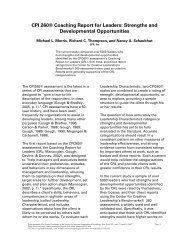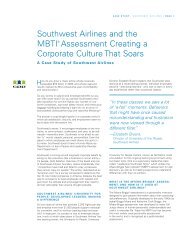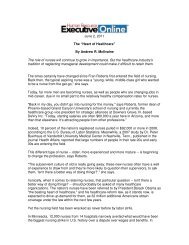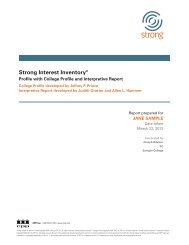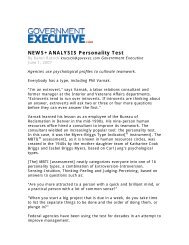Filling the Leadership Pipeline - CPP.com
Filling the Leadership Pipeline - CPP.com
Filling the Leadership Pipeline - CPP.com
- No tags were found...
Create successful ePaper yourself
Turn your PDF publications into a flip-book with our unique Google optimized e-Paper software.
With <strong>the</strong> unemployment rate in <strong>the</strong> United States jumping to8.5 percent in recent months (<strong>the</strong> highest it’s been since 1983,according to <strong>the</strong> U.S. Department of Labor) <strong>the</strong> current recessionis showing few signs of abating.Many blame a lack of governmentoversight in key financial areas andmassive breakdown in corporate governance—from<strong>the</strong> failure of corporateboards to hold executive managementaccountable, to <strong>the</strong> lack of solid,thoughtful succession planning withinorganizations—for <strong>the</strong> current economiccrisis.Unfortunately, <strong>the</strong> fallout from recentcorporate failures, specifically in<strong>the</strong> finance and insurance industries,has had a trickle-down effect that hasleft virtually no one unsca<strong>the</strong>d.As organizations adjust to newbusiness conditions and economicrealities, <strong>the</strong>y are being forced to cutcosts across <strong>the</strong> board, which oftenmeans cutting critical positions, programs,and staff. To navigate through<strong>the</strong> current economic headwinds,many <strong>com</strong>panies will be tempted toapproach cost-cutting by wielding anax ra<strong>the</strong>r than fashioning a plan.They look to reducing headcountand downsizing <strong>the</strong>ir organizationswithout giving much thought to <strong>the</strong>skills, talent, and leadership <strong>the</strong>y arelosing; determing where and howthose skills could add value elsewherein <strong>the</strong> organization; or thinking abouthow <strong>the</strong> loss of particular skills willaffect <strong>the</strong> <strong>com</strong>pany down <strong>the</strong> road.Most damaging, perhaps, is thatmany <strong>com</strong>panies will slash <strong>the</strong>ir investmentsin employee training andleadership development programs,viewing <strong>the</strong>m as “nice-to-haves,” ra<strong>the</strong>rthan critical cornerstones of <strong>the</strong>irbusiness and keys to <strong>the</strong>ir survivalduring tough times.History has shown that eliminatingcorporate initiatives and programsaimed at cultivating employee talent,specifically those focused on managerialand leadership development, putsorganizations at a long-term disadvantagewhen <strong>the</strong> economy does recover.listen to this featureat www.astd.org/TD/TDpodcasts.htmJUNE 2009 | T+D | 49
Companies lookingto emerge from <strong>the</strong>current recessionstronger and betterpositioned to <strong>com</strong>petein <strong>the</strong> new economymust continue toinvest in trainingand developingemployees, with a goalof building a strongleadership pipeline.According to Bersin and Associates,“Organizations cutting costs during<strong>the</strong> 2000 recession eliminated <strong>the</strong> veryprograms that provided <strong>the</strong> trainingand programs necessary for developingleaders. Only later would <strong>the</strong>yrealize that it took at least three yearsto rebuild <strong>the</strong>ir internal expertise andstrategic capabilities.Companies that consistently fostera talent-driven culture, however, havethrived despite current conditions,in great part by maintaining <strong>the</strong>ir<strong>com</strong>mitment to leadership developmentprograms.”Underscoring <strong>the</strong> importance ofleadership development, Hewitt Associates,toge<strong>the</strong>r with RBL and Fortunemagazine, released a global leadershipstudy in 2007 that found that leadershipdevelopment was embedded into <strong>the</strong>culture of top <strong>com</strong>panies. The research<strong>com</strong>pared global top <strong>com</strong>panies withmore than 530 o<strong>the</strong>r organizationsaround <strong>the</strong> globe. The single characteristicthat distinguished <strong>the</strong>se <strong>com</strong>paniesfrom <strong>the</strong> o<strong>the</strong>rs is that <strong>the</strong>y madeleadership a critical part of <strong>the</strong>irorganizational fabric.The imperative is clear. Companieslooking to emerge from <strong>the</strong> current recessionstronger and better positionedto <strong>com</strong>pete in <strong>the</strong> new economy mustcontinue to invest in training anddeveloping employees, with a goal ofbuilding a strong leadership pipeline.While it may be challenging fororganizations to justify <strong>the</strong>se investmentsright now, organizations needto recognize that long-term viabilitydepends on a <strong>com</strong>pany’s ability to developstrong leaders.Who is responsible fordeveloping leaders?From managers to board members,leadership development should notjust be limited to human resourcesor <strong>the</strong> learning organization. Allmanagers are responsible for helping<strong>the</strong>ir employees develop to <strong>the</strong>irfullest potential by continuallychallenging <strong>the</strong>m and increasing <strong>the</strong>irleadership <strong>com</strong>petencies.According to an article published in<strong>the</strong> Harvard Business Review, a part of<strong>the</strong> line manager’s role is recognizing hersubordinates’ developmental needs,helping <strong>the</strong>m develop new skills, andproviding <strong>the</strong>m with opportunities forprofessional and personal growth.These managers need to do this,even if it means pushing rising starsinto different business units. They needto mentor emerging leaders both withinand outside of <strong>the</strong>ir own department, disseminatingkey knowledge and offeringevaluations and feedback. The managers’own evaluations, development plans, andpromotions, depend heavily on how successfully<strong>the</strong>y nurture <strong>the</strong>ir subordinates.Companies are increasingly recognizingthat solid management andleadership make all <strong>the</strong> difference.Good managers and leaders always anticipate<strong>the</strong> need for successors and areprepared. However, since organizationscannot assume that <strong>the</strong> mere existenceof a talent pool guarantees that <strong>the</strong>succession will fit neatly into place,effective succession management demandscareful planning and preparation,mentoring, and grooming.Unfortunately, all too often, leadershipdevelopment and succession planningare managed as separate entitieswithin organizations, despite <strong>the</strong>irshared goal of ensuring <strong>the</strong> right skills,in <strong>the</strong> right place, at <strong>the</strong> right time. Additionally,leadership development isoften reserved for senior executives. Tobuild a strong leadership pipeline atall levels, succession planning must beconsidered part and parcel of <strong>the</strong> leadershipdevelopment process (and viceversa), and must reflect <strong>the</strong> strategicobjectives and goals of <strong>the</strong> <strong>com</strong>pany.Companies that implementsuccession plans focused oncultivating existing talent will nodoubt move into <strong>the</strong> next decadeand economic growth period with asignificant <strong>com</strong>petitive advantage.The new economy requiresnew thinkingOrganizations today, along with <strong>the</strong>government, need to consider how <strong>the</strong>50 | T+D | JUNE 2009 Photos by Shutterstock




